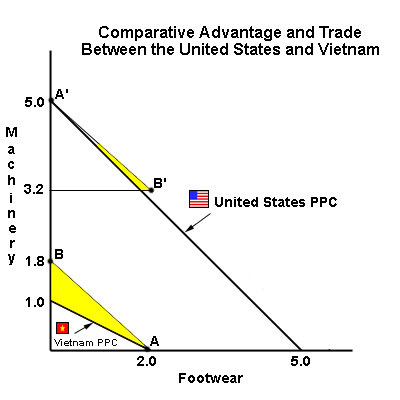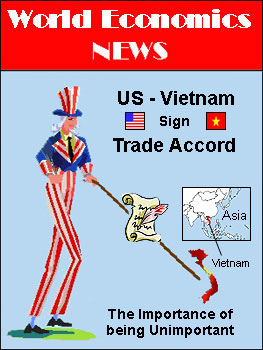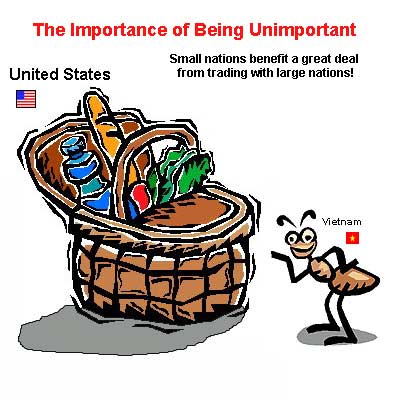
 July
31, 2000 The United States and Vietnam reached a trade agreement
earlier this month that will begin to normalize trade relations between
the two countries. Although the accord is relatively
insignificant
in the context of global trade, it has enormous symbolic worth --
especially
for the United States. It represents the historic healing of deep
wounds that were inflicted when the two countries waged war over a
quarter
of a century ago. "And so from the bitter past, we plant the
seeds
of a better future," remarked President Clinton at the trade agreement
press conference held in the Rose Garden at the White House on July 13.
July
31, 2000 The United States and Vietnam reached a trade agreement
earlier this month that will begin to normalize trade relations between
the two countries. Although the accord is relatively
insignificant
in the context of global trade, it has enormous symbolic worth --
especially
for the United States. It represents the historic healing of deep
wounds that were inflicted when the two countries waged war over a
quarter
of a century ago. "And so from the bitter past, we plant the
seeds
of a better future," remarked President Clinton at the trade agreement
press conference held in the Rose Garden at the White House on July 13.
The agreement involves Vietnamese commitments to allow more open access to U.S. goods and services, lower tariffs, and adherence to the World Trade Organization's (WTO) broad range of standards, including intellectual property protection. Vietnam also agreed to protect U.S. investments from expropriation, eliminate local content requirements, and adopt a fully transparent regime with respect to the agreement's provisions. For its part, the United States will grant Normal Trade Relations (NTR) to Vietnam on an annual basis. That will reduce U.S. tariffs on Vietnamese products to the lowest level granted to any other nation in the world with NTR status.
The biggest economic gains from the agreement between the two countries will likely accrue to Vietnam. That's because of a phenomenon in trade economics called the importance of being unimportant. When two nations begin to trade, they both gain by exploiting their respective comparative advantages and lower internal opportunity costs. If the two nations are approximately the same size with similar tastes and preferences, then they tend to share the gains from trade about equally. However, if one of the nations is much larger (United States) than the other (Vietnam), then the larger nation attains less gain while the smaller, less important nation gets most of the gains. That's because the international terms of trade for the goods and services traded tends to be closer to the larger nation's internal terms of trade. (The terms of trade in this context refers to the ratio of a country's export prices to its import prices). Small nations also benefit immensely from technology developed in the larger industrialized countries.
In trading with the United States, Vietnam's comparative advantages will be in products such as textiles, garments, and footwear due to its relatively low labor costs. The United States' comparative advantages will be in high technology machinery, pharmaceuticals, and financial services. Both countries will gain when they begin to trade these goods and services, but the terms of trade are likely to favor Vietnam. The diagram below illustrates what is likely to happen as trade patterns between the United States and Vietnam begin to unfold in the years ahead.

The diagram above shows the United States to be a much larger economy than Vietnam. Each country could produce combinations of machinery and footwear along their respective production possibilities curves (PPC). The diagram also indicates that Vietnam has a comparative advantage in the production of footwear, because each unit of footwear that it produced would have the (opportunity) cost of 0.5 machines. In the United States each unit of footwear would cost 1 machine -- twice as much as in Vietnam. These internal cost differentials are the basis for trade between the two nations. Both countries would gain if the United States specialized in the production of machines (point A') while Vietnam specialized in the production of footwear (point A) and then traded with each other. The international terms of trade in the diagram are assumed to be 0.9 That is, each unit of footwear is assumed to cost 0.9 machines in the international market. That terms of trade is very close to the cost of footwear in the United States without trade. Thus, if Vietnam traded away all of the footwear that it produced (2.0 units) it could obtain 1.8 machines (point B) from the United States. The United States would get Vietnam's 2.0 units of footwear for the1.8 machines that it traded away (point B'). The gains from trade for each country are shown by the yellow shaded areas. Because the international terms of trade rest close to the larger country's internal terms of trade, the smaller country (Vietnam) gains more from trade than the larger country (United States).

Images are the property of NVTech
The actual volume of trade between the United States and Vietnam is currently of relatively small importance to either country, and that is not likely to change even in the wake of their new bilateral trade agreement. Because of its location, Vietnam trades primarily with other Asian countries. Its biggest trading partners are Japan, Singapore, Korea, and Taiwan. However, the agreement with United States is another indication that Vietnam is joining the ranks of those emerging economies that are opening their borders to trade. It joined the Association of Southeast Asian Nations (ASEAN) in 1995 and the Asia Pacific Economic Cooperation (APEC) in 1998.
Like many other Asian economies, Vietnam has been experiencing rapid economic growth. Its annual growth rate in real GDP exceeded 8 per cent for most years during the 1990s. The economy was slowed, however, by the Asian financial crisis in 1997-98. The International Monetary Fund projects Vietnam's growth rate to be 4.5 % this year and 5.5 % next year. Inflation is expected to be 6.0 % this year and 4.5 per cent next year. By opening its borders to freer trade and arresting the magic of comparative advantage, Vietnam's growth will be enhanced and inflation will be diminished over the long run. On the other hand, rapidly growing transitional economies necessarily confront the problems of structural unemployment and social and environmental disruptions. These fundamental economic tradeoffs require delicate political balancing. International cooperation like the US-Vietnam Bilateral Trade Agreement can make it easier for all the countries to achieve a satisfactory macoreconomic performance.
Recommended Links:
U.S. State Department.US-Vietnam Relations: http://www.usinfo.state.gov/regional/ea/vietnam
Vietnam Economy: http://www.vneconomy.com.vn